| Article ID | Journal | Published Year | Pages | File Type |
|---|---|---|---|---|
| 1289577 | Journal of Power Sources | 2011 | 9 Pages |
In this study, anode- and electrolyte-supported Ni-YSZ/YSZ/Pt solid oxide fuel cells (SOFC) are compared in terms of performance and carbon formation when operated on dry methane. Although anode-supported SOFCs are typically used in industry, electrolyte-supported cells may be required for certain laboratory experiments. Thermodynamic calculations were performed to calculate the equilibrium gas-phase composition. The measured open circuit voltages (OCV) in dry methane were 1.15 V and 0.92 V for anode- and electrolyte-supported cells, respectively. The difference in these OCV values reflects the different gas-phase compositions at the electrochemically active region of the two cell designs. The conduction layer in the anode-supported SOFC provides the catalytic sites to produce more hydrogen, which results in a higher OCV and a larger limiting current density. Over time, carbon is also produced and results in a higher degradation rate on the anode-supported cell. Carbon also forms on the electrolyte-supported cell but has less of a negative impact on the operation of the electrolyte-supported cell. Temperature-programmed oxidation (TPO) studies indicate that the carbon formed in the conduction layer of an anode-supported cell is much more stable and difficult to remove than carbon formed on the functional layer.
